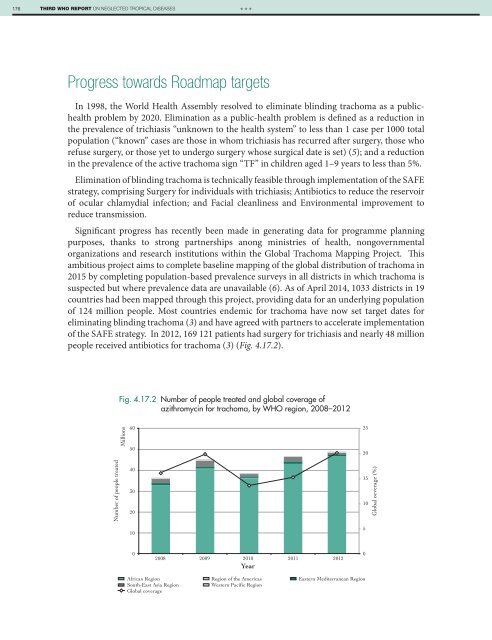1A9bnbK
1A9bnbK
1A9bnbK
You also want an ePaper? Increase the reach of your titles
YUMPU automatically turns print PDFs into web optimized ePapers that Google loves.
176 THIRD WHO REPORT ON NEGLECTED TROPICAL DISEASES<br />
***<br />
Progress towards Roadmap targets<br />
In 1998, the World Health Assembly resolved to eliminate blinding trachoma as a publichealth<br />
problem by 2020. Elimination as a public-health problem is defined as a reduction in<br />
the prevalence of trichiasis “unknown to the health system” to less than 1 case per 1000 total<br />
population (“known” cases are those in whom trichiasis has recurred after surgery, those who<br />
refuse surgery, or those yet to undergo surgery whose surgical date is set) (5); and a reduction<br />
in the prevalence of the active trachoma sign “TF” in children aged 1–9 years to less than 5%.<br />
Elimination of blinding trachoma is technically feasible through implementation of the SAFE<br />
strategy, comprising Surgery for individuals with trichiasis; Antibiotics to reduce the reservoir<br />
of ocular chlamydial infection; and Facial cleanliness and Environmental improvement to<br />
reduce transmission.<br />
Significant progress has recently been made in generating data for programme planning<br />
purposes, thanks to strong partnerships anong ministries of health, nongovernmental<br />
organizations and research institutions within the Global Trachoma Mapping Project. This<br />
ambitious project aims to complete baseline mapping of the global distribution of trachoma in<br />
2015 by completing population-based prevalence surveys in all districts in which trachoma is<br />
suspected but where prevalence data are unavailable (6). As of April 2014, 1033 districts in 19<br />
countries had been mapped through this project, providing data for an underlying population<br />
of 124 million people. Most countries endemic for trachoma have now set target dates for<br />
eliminating blinding trachoma (3) and have agreed with partners to accelerate implementation<br />
of the SAFE strategy. In 2012, 169 121 patients had surgery for trichiasis and nearly 48 million<br />
people received antibiotics for trachoma (3) (Fig. 4.17.2).<br />
Fig. 4.17.2 Number of people treated and global coverage of<br />
azithromycin for trachoma, by WHO region, 2008–2012<br />
Number of people treated<br />
Millions<br />
60<br />
50<br />
40<br />
30<br />
20<br />
10<br />
25<br />
20<br />
15<br />
10<br />
5<br />
Global ocverage (%)<br />
0<br />
2008 2009 2010 2011 2012<br />
Year<br />
0<br />
African Region Region of the Americas Eastern Mediterranean Region<br />
South-East Asia Region<br />
Western Pacific Region<br />
Global coverage


